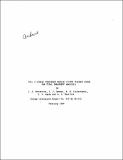| dc.contributor.author | Westerink, Joannes J. | en_US |
| dc.date.accessioned | 2011-01-14T23:20:32Z | |
| dc.date.available | 2011-01-14T23:20:32Z | |
| dc.date.issued | 1984 | en_US |
| dc.identifier.uri | http://hdl.handle.net/1721.1/60610 | |
| dc.description.abstract | A frequency domain (harmonic) finite element model is developed for the numerical prediction of depth average circulation within small embayments. Such embayments are often characterized by irregular boundaries and bottom topography and large gradients in velocity. Previously developed finite element based time domain models require high eddy viscosity coefficients and small time steps to insure numerical stability, making application to small bays infeasible. Application of the harmonic method in conjunction with finite elements overcomes theseproblems. The model TEA, for Tidal Embayment Analysis, solves the linearized problem and is the core of a fully nonlinear code presently under development. | en_US |
| dc.description.abstract | This report discusses in detail both the theory behind TEA and program usage. Furthermore the versatility of TEA is demonstrated in several prototype examples. | en_US |
| dc.format.extent | iii, 143 p | en_US |
| dc.publisher | [Cambridge, Mass.] : Massachusetts Institute of Technology, Energy Laboratory and R.M. Parsons Laboratory for Water Resources and Hydrodynamics, Dept. of Civil Engineering, 1984 | en_US |
| dc.relation.ispartofseries | Energy Laboratory report (Massachusetts Institute of Technology. Energy Laboratory) no. MIT-EL 84-012. | en_US |
| dc.title | TEA - a linear frequency domain finite element model for tidal embayment analysis | en_US |
| dc.title.alternative | Linear frequency domain finite element model for tidal embayment analysis. | en_US |
| dc.identifier.oclc | 12114418 | en_US |

